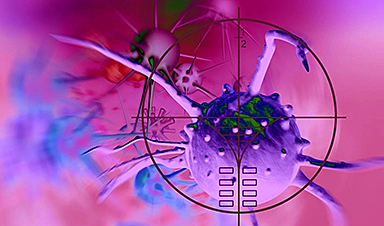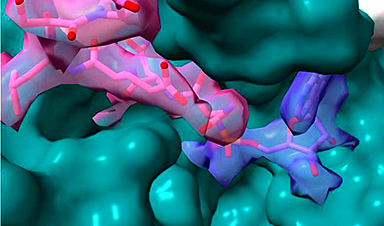Recent research illustrates how RNA molecules’ chemical characteristics might have played a crucial role in the development of complex life forms.
How did complex life manage to evolve on the early, inhospitable Earth? Initially, ribonucleic acid (RNA) must have existed to carry the first genetic information. For these biomolecules to build-up complexity in their sequences, they needed to release water. However, on the early Earth, which was predominantly covered in seawater, this process was challenging.
In a paper recently published in the Journal of the American Chemical Society (JACS), researchers from the team of LMU professor Dieter Braun have shown that in RNA’s struggle with the surrounding water, its natural recycling capabilities, and the right ambient conditions could have been decisive.
“The building blocks of RNA release a water molecule for every bond they form in a growing RNA chain,” explains Braun, spokesperson for the Collaborative Research Centre (CRC) Molecular Evolution in Prebiotic Environments and coordinator at the ORIGINS Excellence Cluster. “When, conversely, water is added to an RNA molecule, the RNA building blocks are fed back into the prebiotic pool.”
This turnover of water works particularly well under low saline conditions with high pH levels. “Our experiments indicate that life could emerge from a very small set of molecules, under conditions such as those prevailing on volcanic islands on the early Earth,” says Adriana Serrão, lead author of the study.
A New Understanding of RNA Evolution
Under these conditions, RNA has the ability to split without adding a water molecule. The end of the RNA strand remains water-free and can spontaneously re-form new RNA bonds. Braun’s laboratory demonstrated that the rebinding of this split RNA works efficiently and with remarkable precision when copying the sequence information. This process only takes place when the RNA building blocks are bound to a template RNA molecule with precisely matching base pairs in a double-stranded configuration. This produces a copy of the existing RNA strand before it disintegrates through the addition of water.
It had previously been assumed that RNA can only copy itself by ‘randomly’ constructing sequences of around 200 nucleotides in length – so-called ribozymes. However, ribozymes can operate only in saline, and thus RNA-hostile, environments. As a result of this new research, these complex ribozyme sequences in the early stages of RNA evolution are not necessary. “The precision is comparable to the copying of RNA achieved by ribozymes,” says Sreekar Wunnava, also lead author of the study. “This means that an RNA world could arise without the prior necessity for long complex sequences.”
Early life thus consisted of a very simple metabolic process whereby RNA sequences were copied by means of continuous replacement with recycled molecules. All that is needed for this to happen is an alkaline freshwater environment such as still exist today on volcanic islands like the Hawaiian archipelago or Iceland. “And so life could have emerged from a simple, cold prebiotic primordial soup of RNA building blocks,” explains Braun. Although the reactions take place very slowly under these conditions and require several days to complete, there was no shortage of time at the start of evolution and the cold freshwater refuges on primeval volcanic islands allowed RNA to survive on the otherwise inhospitable early Earth.
Reference: “High-Fidelity RNA Copying via 2′,3′-Cyclic Phosphate Ligation” by Adriana Calaça Serrão, Sreekar Wunnava, Avinash V. Dass, Lennard Ufer, Philipp Schwintek, Christof B. Mast and Dieter Braun, 19 March 2024, Journal of the American Chemical Society.
DOI: 10.1021/jacs.3c10813
News
Repurposed drugs could calm the immune system’s response to nanomedicine
An international study led by researchers at the University of Colorado Anschutz Medical Campus has identified a promising strategy to enhance the safety of nanomedicines, advanced therapies often used in cancer and vaccine treatments, [...]
Nano-Enhanced Hydrogel Strategies for Cartilage Repair
A recent article in Engineering describes the development of a protein-based nanocomposite hydrogel designed to deliver two therapeutic agents—dexamethasone (Dex) and kartogenin (KGN)—to support cartilage repair. The hydrogel is engineered to modulate immune responses and promote [...]
New Cancer Drug Blocks Tumors Without Debilitating Side Effects
A new drug targets RAS-PI3Kα pathways without harmful side effects. It was developed using high-performance computing and AI. A new cancer drug candidate, developed through a collaboration between Lawrence Livermore National Laboratory (LLNL), BridgeBio Oncology [...]
Scientists Are Pretty Close to Replicating the First Thing That Ever Lived
For 400 million years, a leading hypothesis claims, Earth was an “RNA World,” meaning that life must’ve first replicated from RNA before the arrival of proteins and DNA. Unfortunately, scientists have failed to find [...]
Why ‘Peniaphobia’ Is Exploding Among Young People (And Why We Should Be Concerned)
An insidious illness is taking hold among a growing proportion of young people. Little known to the general public, peniaphobia—the fear of becoming poor—is gaining ground among teens and young adults. Discover the causes [...]
Team finds flawed data in recent study relevant to coronavirus antiviral development
The COVID pandemic illustrated how urgently we need antiviral medications capable of treating coronavirus infections. To aid this effort, researchers quickly homed in on part of SARS-CoV-2's molecular structure known as the NiRAN domain—an [...]
Drug-Coated Neural Implants Reduce Immune Rejection
Summary: A new study shows that coating neural prosthetic implants with the anti-inflammatory drug dexamethasone helps reduce the body’s immune response and scar tissue formation. This strategy enhances the long-term performance and stability of electrodes [...]
Scientists discover cancer-fighting bacteria that ‘soak up’ forever chemicals in the body
A family of healthy bacteria may help 'soak up' toxic forever chemicals in the body, warding off their cancerous effects. Forever chemicals, also known as PFAS (per- and polyfluoroalkyl substances), are toxic chemicals that [...]
Johns Hopkins Researchers Uncover a New Way To Kill Cancer Cells
A new study reveals that blocking ribosomal RNA production rewires cancer cell behavior and could help treat genetically unstable tumors. Researchers at the Johns Hopkins Kimmel Cancer Center and the Department of Radiation Oncology and Molecular [...]
AI matches doctors in mapping lung tumors for radiation therapy
In radiation therapy, precision can save lives. Oncologists must carefully map the size and location of a tumor before delivering high-dose radiation to destroy cancer cells while sparing healthy tissue. But this process, called [...]
Scientists Finally “See” Key Protein That Controls Inflammation
Researchers used advanced microscopy to uncover important protein structures. For the first time, two important protein structures in the human body are being visualized, thanks in part to cutting-edge technology at the University of [...]
AI tool detects 9 types of dementia from a single brain scan
Mayo Clinic researchers have developed a new artificial intelligence (AI) tool that helps clinicians identify brain activity patterns linked to nine types of dementia, including Alzheimer's disease, using a single, widely available scan—a transformative [...]
Is plastic packaging putting more than just food on your plate?
New research reveals that common food packaging and utensils can shed microscopic plastics into our food, prompting urgent calls for stricter testing and updated regulations to protect public health. Beyond microplastics: The analysis intentionally [...]
Aging Spreads Through the Bloodstream
Summary: New research reveals that aging isn’t just a local cellular process—it can spread throughout the body via the bloodstream. A redox-sensitive protein called ReHMGB1, secreted by senescent cells, was found to trigger aging features [...]
AI and nanomedicine find rare biomarkers for prostrate cancer and atherosclerosis
Imagine a stadium packed with 75,000 fans, all wearing green and white jerseys—except one person in a solid green shirt. Finding that person would be tough. That's how hard it is for scientists to [...]
Are Pesticides Breeding the Next Pandemic? Experts Warn of Fungal Superbugs
Fungicides used in agriculture have been linked to an increase in resistance to antifungal drugs in both humans and animals. Fungal infections are on the rise, and two UC Davis infectious disease experts, Dr. George Thompson [...]





















